日本变种Ostreid Herpesvirus 1 (OsHV-1) JPType1在太平洋牡蛎长牡蛎幼虫和幼鱼中的实验感染
IF 0.2
4区 农林科学
Q4 FISHERIES
引用次数: 1
摘要
在世界上许多地方,OsHV-1感染与太平洋牡蛎长牡蛎的死亡有关,主要发生在夏季。在本研究中,通过实验感染来研究OsHV·1JPType1(一种日本变种)在孵化场饲养的太平洋牡蛎幼虫和幼崽中的致病性。从海笼中获得的死牡蛎口制备了jp1型病毒,并将其作为感染实验的接种源传给牡蛎幼虫。当病毒浓度分别为3.2× 106、3.2× 105和3.2×104时,d型幼虫对感染更敏感。实时荧光定量PCR检测结果显示,d型幼虫混合样本中病毒DNA拷贝数为1.6× 108个/ng。9组不同大小的贝体(平均壳高1.8 ~ 6.1 mm)浸泡在含有2.5×106病毒DNA拷贝数/ml的海水中,5天后未见死亡;然而,在一组口蹄疫中检测到6.3×105病毒DNA拷贝数/mg全重。小贝组的病毒浓度高于大贝组。证实了OsHV 1JPType1在幼虫和幼体中的致病性;然而,随着牡蛎的生长,它逐渐减少。本文章由计算机程序翻译,如有差异,请以英文原文为准。
Experimental Infection of Ostreid Herpesvirus 1 (OsHV-1) JPType1, a Japanese Variant, in Pacific Oyster Crassostrea gigas Larvae and Spats
In many locations worldwide, ostreid herpesvirus 1 (OsHV-1) infections are associated with mortalities in Pacific oyster Crassostrea gigas primarily during the summer months. In the present study, experimental infections were performed to investigate the pathogenicity of OsHV・1JPType1 (a Japanese variant) in hatchery-reared Pacific oyster larvae and spats. The JPType1 virus was prepared from dead oyster spats obtained from a sea cage and was once passed in oyster larvae as the inoculum source of the infection experiments. Compared to pediveliger larvae, D-shaped larvae were more susceptible to infections when the larvae were exposed to serially diluted virus solutions at the concentrations of 3.2 x 106, 3.2 x 105 and 3.2×104 virus DNA copies/ml. Real-time PCR analysis revealed 1.6× 108 virus DNA copies/ng total DNA in a pooled sample of D-shaped larvae. No mortality was observed after 5 days when nine spat groups of differently sizes (mean shell height from 1.8 mm to 6.1 mm) were immersed in seawater containing 2.5×106 virus DNA copies/ml; however, 6.3×105 virus DNA copies/mg whole weight were detected in a group of spats. Virus concentrations were higher in smaller spat groups than in larger spat groups. The pathogenicity of OsHV司 1JPType1 in larvae and spats was confirmed; however, i t declined with the growth of the oyster.
求助全文
通过发布文献求助,成功后即可免费获取论文全文。
去求助
来源期刊

Fish Pathology
农林科学-兽医学
CiteScore
1.40
自引率
16.70%
发文量
13
审稿时长
6 months
期刊介绍:
Information not localized
 求助内容:
求助内容: 应助结果提醒方式:
应助结果提醒方式:


